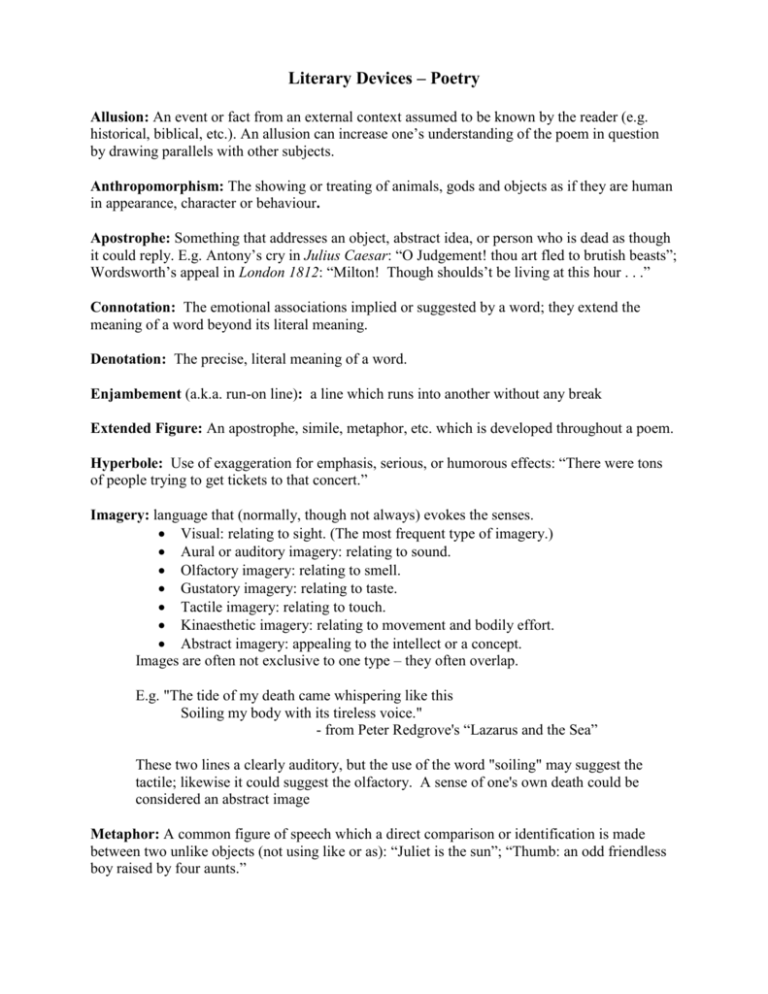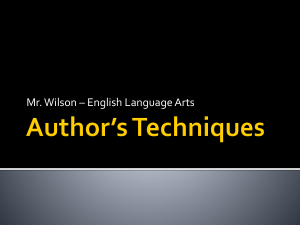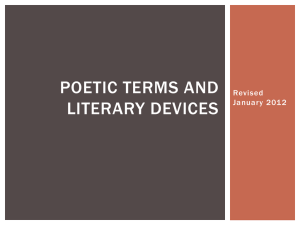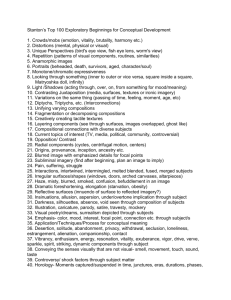Literary Devices – Poetry
advertisement

Literary Devices – Poetry Allusion: An event or fact from an external context assumed to be known by the reader (e.g. historical, biblical, etc.). An allusion can increase one’s understanding of the poem in question by drawing parallels with other subjects. Anthropomorphism: The showing or treating of animals, gods and objects as if they are human in appearance, character or behaviour. Apostrophe: Something that addresses an object, abstract idea, or person who is dead as though it could reply. E.g. Antony’s cry in Julius Caesar: “O Judgement! thou art fled to brutish beasts”; Wordsworth’s appeal in London 1812: “Milton! Though shoulds’t be living at this hour . . .” Connotation: The emotional associations implied or suggested by a word; they extend the meaning of a word beyond its literal meaning. Denotation: The precise, literal meaning of a word. Enjambement (a.k.a. run-on line): a line which runs into another without any break Extended Figure: An apostrophe, simile, metaphor, etc. which is developed throughout a poem. Hyperbole: Use of exaggeration for emphasis, serious, or humorous effects: “There were tons of people trying to get tickets to that concert.” Imagery: language that (normally, though not always) evokes the senses. Visual: relating to sight. (The most frequent type of imagery.) Aural or auditory imagery: relating to sound. Olfactory imagery: relating to smell. Gustatory imagery: relating to taste. Tactile imagery: relating to touch. Kinaesthetic imagery: relating to movement and bodily effort. Abstract imagery: appealing to the intellect or a concept. Images are often not exclusive to one type – they often overlap. E.g. "The tide of my death came whispering like this Soiling my body with its tireless voice." - from Peter Redgrove's “Lazarus and the Sea” These two lines a clearly auditory, but the use of the word "soiling" may suggest the tactile; likewise it could suggest the olfactory. A sense of one's own death could be considered an abstract image Metaphor: A common figure of speech which a direct comparison or identification is made between two unlike objects (not using like or as): “Juliet is the sun”; “Thumb: an odd friendless boy raised by four aunts.” Metonymy: A figure of speech in which an object’s name is substituted by its function or a word closely associated with it: “The law is at the door” (law = police). Personification: A figure of speech attributing human qualities to inanimate objects or abstract ideas: “The houses gazed at each other”; “the yellow fog rubs its back upon the window pane.” Refrain: A repeated line, phrase, sentence, etc. which appears throughout a poem. Simile: A figure of speech comparing two dissimilar things, using the words like or as: “My love is like a rose”; “the thunder sounded like a mean dog’s growl”. Synecdoche: The substitution of a part of one thing to represent the whole. E.g. from Thomas Campbell’s “Ye Mariners of England”, ‘oak” represents both Britannia’s warships as well as the material from which they were made: “With thunders from her native oak, / She quells the flood below.” Synecdoche is also common in everyday speech. In the phrase “The Senators won the game”, ‘Senators’ stands for ‘The Ottawa Senators NHL team’. Sound Devices Alliteration: The repetition of initial consonant sounds: “wild and wooly”; “do or die”. Assonance: The repetition of vowel sounds, which may add to euphony: “slap dash”; “mad as a hatter”. Cacophony/dissonance: The use of harsh, discordant, dissonant sounds for poetic effect. E.g. “All day cars mooed and shrieked. Hollered and bellowed and wept.” (traffic) Consonance: The close repetition of identical consonant sounds before and after different vowels: “slip – slop”; “creak – croak”; black – block”; “struts and frets”. Euphony: The pleasant, musical quality produced by agreeable sounds and images in a line of poetry: “And the words hung hushed in their long white dream. By the ghostly, glimmering ice blue stream” (soft sounds and soft images) Meter: A system for identifying and measuring the rhythmic pattern according to its stressed and unstressed syllables. E.g. Iambic pentameter: five metrical feet, each composed of an unstressed syllable followed by a stressed one (an iamb): Following is an example from Shakespeare’s “Sonnet XVIII”: Shall I compare thee to a summer's day? Thou art more lovely and more temperate: Rough winds do shake the darling buds of May. And summer's lease hath all too short a date . . . Onomatopoeia: Words which represent a sound. (“SHAZAM!”; “click”) Phonetic Intensive: A word whose sound emphasizes its meaning, though not onomatopeaiac. Prose: Language which is not in meter. Sometimes even poems can be written in prose.








